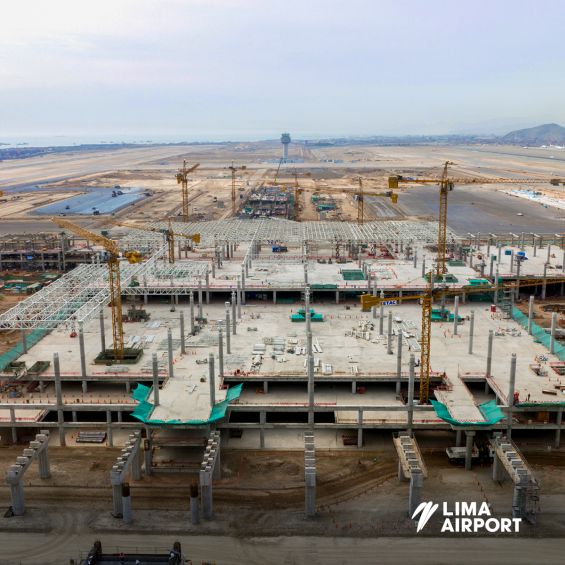In Peru, the countdown is on for the Jorge Chávez International Airport.
The new airport terminal, scheduled to be inaugurated in January 2025, will be a modern city with runways.
The new airport will have numerous facilities for aviation and non-aviation activities, including logistics and cargo areas, hangars, offices, warehouses, parking, hotels, stores, and more.

Although operations will begin in 2025, the plan is to modernize the airport city by 2051.
The new airport will have a total area of about 900 hectares (equivalent to Lima’s Miraflores district), with two runways, a new control tower, and a single passenger terminal, accompanied by various service and commercial areas.
“Our investment in the works of the expansion project amounts to more than US$2 billion.”
“We look forward to the future of Jorge Chávez as a commercial exchange platform that will be perfectly integrated into the city,” said Lorena Trelles, Lima Airport Partners (LAP) representative.
She recalled that the new control tower and second runway were put into operation last April.
The new 65-meter-high control tower and 3,480-meter-long second runway are being built, along with a network of more than 10 kilometers of new taxiways.
The second runway now has a modern asphalt surface and is being used progressively, as determined by the relevant authorities.
“The new Jorge Chávez International Airport will be a safe, friendly, and sustainable place for all its passengers.”
“This new 900-hectare infrastructure will have a new detection system that includes video analysis and detection sensors throughout the airport premises,” Trelles stresses, revealing that the entry of external vehicles onto the apron will be controlled and their movement and dwell time monitored.
The system reads license plates and, in coordination with the Peruvian National Police, sounds the alarm if it detects a problem.
The company points out that the entire airport infrastructure will be “intelligent,” as it will have a centralized control system for the various airport buildings to make them “smart buildings.”
“This platform will allow the airport to control and manage variables as diverse as lighting, alarms, climate, energy, security, etc., through a single system.”
“Additionally, the system will provide the energy information the organization needs to identify potential areas of improvement to cover energy costs through efficient use of resources,” Trelles explains.
Security cameras will be installed in the new passenger terminal, connected to a video surveillance system that will monitor the path of users and have alarms to report incidents.
They will also allow online recordings. In addition, the airport will have a large operational control center (OCC) from which the resources and operations necessary for the proper operation will be managed and monitored in real time.
Flight information screens will be larger and provide additional information about flights, such as the flight route, estimated destination, and departure time.
The airport will be equipped with an early warning system for earthquakes and tsunamis through the installation of sensors (accelerometers) in the terminal and constant communication with the Institute for Civil Defense (Indeci).”

NEW SINGLE-PASSENGER TERMINAL
Trelles points out that the single passenger terminal is 36% complete and the infrastructure 71% complete.
The new passenger terminal will have five floors (a basement and four other floors) and three docking stations for passenger embarkation and disembarkation: one exclusively for domestic passengers, another for international passengers, and the central docking station, which will be mixed.
“It has a modern design inspired by the Nazca culture (it has the shape of a hummingbird) and will serve passengers from domestic and international flights.”
“It will be the first airport terminal in South America to have seismic isolation devices, a technology that isolates the seismic movements of the structure.”
According to the schedule, the terminal will be 68% complete by the end of the year.
“To date, the construction of the entire project has created more than 15,000 jobs, with 20% of the unskilled labor coming from the AID (Area of Direct Influence) area, and we are prioritizing hiring skilled labor from the Callao region.”
The new passenger terminal will be operational in January 2025.
It will comply with the Optimum Service Level of the IATA (International Air Transport Association) manual, with an approximate capacity of 30 million passengers per year and a built-up area of 210,000 square meters.
The capacity of the current Jorge Chávez is 15 million passengers per year and fifteen months after opening, the LAP will have additional areas in operation, reaching a capacity of approximately 40 million passengers per year.
The country’s airport city, currently under construction, will consist of four areas:
1. North Header
This area is located in the northeast of the airport site.
It covers an area of 21 hectares, where the Callao Logistics Park will be built.
At the end of 2023, the first stage will be inaugurated, and the first metal supports of the warehouses will be installed.
2. Santa Rosa
This is the largest site in the airport city, as it will be located in front of the new passenger terminal.
It has a total area of about 64 hectares and six areas.
It will be carried out in several stages, and various properties will be built, such as hotels, offices, parking lots, aviation services, etc.
3. Gambetta
It is located in the southwest of the airport area and has an area of about 41 hectares.
The airport’s new aviation fuel plant will be built in this area.
The first phase will be the new aviation fuel system’s design, construction, and operation.
The remainder of the site will develop a free zone, logistics warehouses, food service establishments, and a gas station.
4. Faucett
This area corresponds to the existing passenger terminal building.
This area will be developed once the terminal under construction is operational.
One area will be reserved for aeronautical activities and commercial use, offices, and parking.
News Peru, English news Peru, Peru’s Jorge Chávez International Aiport

